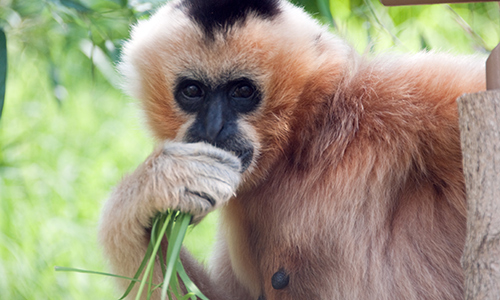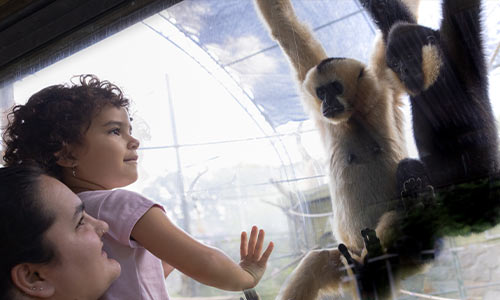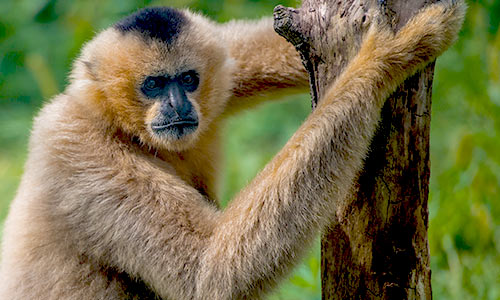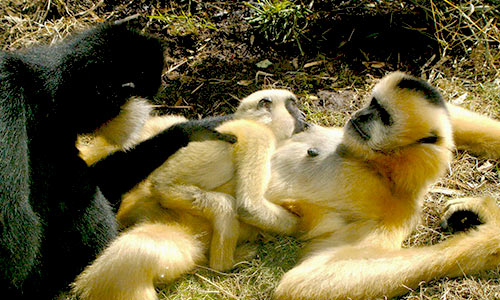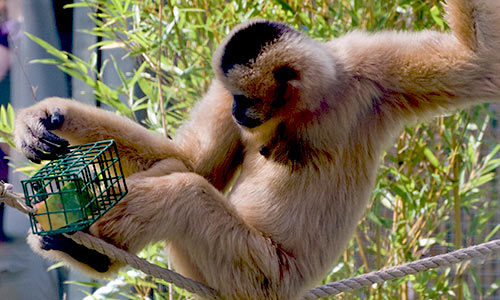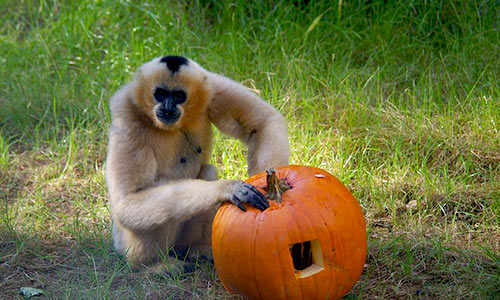Appearance:
Gibbons are small, slender, tree-dwelling apes. Their arms are considerably longer than their legs. When they’re on the ground, gibbons walk on their legs, often with their long arms held above their heads for balance. Like all apes, gibbons don’t have tails. Their body is covered with light-colored to very dark brown or black hair, except on the face, fingers, palms, armpits and bottoms of feet. They have four long fingers, five toes and an opposable thumb and big toe. Gibbons have color vision similar to that of humans.
Size:
In general, females are shorter than males, but may be heavier.
Height/Length: Approximately three feet
Weight: 15 – 30 pounds
Diet:
75 percent of gibbons’ diet is fruit. Leaves, flowers, seeds, tree bark, plant shoots, insects, spiders, bird eggs, and small birds are also eaten. As fruit-eaters, gibbons help re-seed the forest by dropping unwanted fruits to the forest floor.
Reproduction:
Gibbons are monogamous, and mates stay together for life. They’re sexually mature at 12 to 13 years of age. Gestation lasts seven months, and typically one baby is born (occasionally twins). Babies cling to their mother’s belly shortly after birth, wean at one year, and stay with the family group for 6 to 8 years. They then either venture out of the family group to start their own group, or they can even be forced out.
Behavior:
Gibbons are diurnal (active during the day), and they sleep sitting upright. They're social animals, living in small, stable family groups consisting of a mated pair and their juvenile offspring. Grooming each other is a common activity.
Gibbons spend most of their lives in trees and move by swinging between branches and vines using their arms (this is called brachiating). They use the four fingers of their hands, but not the thumb, to hook onto branches. They can also leap across gaps in the tree canopy up to 30 feet. Gibbons can’t swim, and they avoid water.
Families occupy a territory of about 30 to 50 acres, and gibbons will defend it with vigorous vocal and visual displays consisting of menacing gestures, hooting calls and haunting “songs” (which can be heard up to two miles away!). Calls, originated by the dominant female, are often made each morning and repeated throughout the day.
Habitat/Range:
White-cheeked gibbons are found in the tropical and subtropical rainforests of Southeast Asia. Small populations exist in Vietnam, Lao People's Democratic Republic and possibly China.
Life Expectancy:
Average 27.5 years
Conservation status:
Endangered primarily to loss of habitat.
- Northern white-cheeked gbbons are critically endangered
- Southern white-cheeked gibbons are endangered
Fun Fact:
Gibbons have senses, including color vision, that are similar to those of humans.

